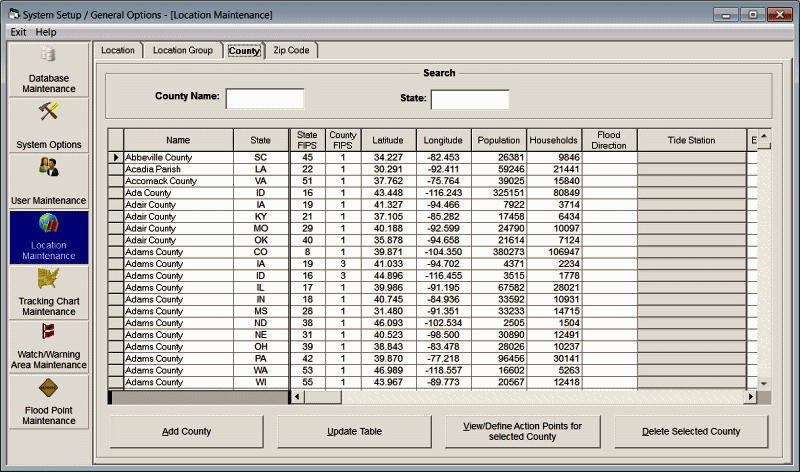
Location Maintenance - Counties

This option allows the user to establish new or change/delete existing counties. The latitude and longitude values are the geographical center position of the county. Remember western longitudes are negative while eastern longitudes are positive.
Name - This identifies the county's name
State - This identifies the county's state code (2 digits)
State FIPS - This identifies the county's state FIPS code
County FIPS - This identifies the county's FIPS code
Latitude - This identifies the county's geographical center latitude in decimal degrees. All latitudes north of the equator are positive and those south are negative. Latitudes for the North Atlantic and Eastern Pacific are positive. NOTE: DO NOT USE DEGREES AND MINUTES. To convert degrees/minutes to degrees and tenths of a degree, take the number of minutes, divide by 60 and add it to the degree value. I.E. 29 degrees 36 minutes is 29.6 degrees.
Longitude - This identifies the county's geographical center longitude in decimal degrees. All Western longitudes are negative while all Eastern longitudes are positive. Longitude values for the Atlantic and Eastern Pacific locations are negative. NOTE: DO NOT USE DEGREES AND MINUTES. To convert degrees/minutes to degrees and tenths of a degree, take the number of minutes, divide by 60 and add it to the degree value. I.E. -78 degrees 54 minutes is -78.9 degrees.
Population - This represents the population of the county. The system comes supplied with 2000 census data.
Households - This represents the number of households in the county. The system comes supplied with the 1997 census data.
Flood Direction - This identifies the direction that flooding typically occurs from. For example, in Miami a direct East wind (090 degrees) is the direction that flooding occurs. In Panama City, FL, the direction is more like SSW or 200 degrees. This is used in the detail location reports when calculating onshore wind flow and the flood index. At the county level this value may not be meaningful. I.E. Monroe County, FL (Fla. Keys)..
Tide Station - This identifies the tide station associated with this county location. To associate a location to a tide station, click on this data cell. The user will then be presented with a tide station selection window.
Average Roughness Index - This represents the average roughness index for this county. This is used for the county wind impact report when Advanced Wind Estimation (for counties ) is active (ON). This value has been pre-calculated and should be changed with care.
User defined field 1 - This represents numerical data that is defined by the user. In the example shown here, we picked data fields that may be of interest to the insurance industry. If you have a large quantity of user data that you would like to import into the database it may be best to use MS ACCESS to do the chore rather than hand data entry. Call PC Weather Products for assistance in doing this.
User defined fields 2-10 - This represents numerical data that is defined by the user as described above.
The options available from here are:
To ADD a county, select the add county option.
To Change a county's information, make the required changes in the data table and select update table.
To DEFINE ACTION POINTS, highlight that county in the list and select the View/Define Action Point option.
To DELETE a county, highlight that county in the list and select the delete option.
Note: To find a county, use the search fields